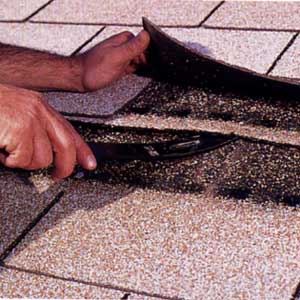 Prior to the attachment of any shingles, you should verify that proper roof edging and underlayment are in place. These two elements are essential for a waterproof roof. With this verified, and a permit obtained, you can begin installing asphalt shingles.
Prior to the attachment of any shingles, you should verify that proper roof edging and underlayment are in place. These two elements are essential for a waterproof roof. With this verified, and a permit obtained, you can begin installing asphalt shingles.
Heavy rain or snow can jam water under the shingles on your roof. To protect your roof from the elements, I would suggest applying a self-adhesive layer of waterproofing. This adhesive should stick tightly with the bare sheathing and seals around the nails that you drive through. Some regions have building codes which requires 3-6 feet of adhesive to come up from the eave. Check the area’s coding laws to make sure you are within requirements.
Next you will cover the roof with a #15 asphalt felt. Each layer of asphalt should overlay the next layer by at least 2 inches. Follow this process by nailing drip edges along the rakes, or the side of the roof, above the underlayers. A done with the flashings, make sure you overlay upper pieces on the lower pieces. The asphalt felt helps to keep the roof deck moisture free before the shingles go on.
Now you will need to find the center of the roof at the top. Snap on a vertical chalk line. Many experts like to use this line as a place to start the shingling, working outward to the edges.
The first row of shingles, known as the starter strip, will require you to cut the tabs off of 3-tabbed shingles and apply them with your adhesive strip facing up along the edge. Make sure this row as a minor overhanging of about 1/4 inches beyond the edge. This starter protects the roof by filling in spots under the joints of the next row of shingles. The adhesive on this row will seal the tabs of the first cull course.
Next you will nail the next group of shingles directly on top and aligned with the starter course. Use 4 nails per shingle, or 6 if you live in a windy area. Once this path is laid out you can begin snapping in horizontal chalk lines up the roof to make sure the lines are straight. Make sure you expose up to 5 inches of single tabs where the bottom edge meets the top.
